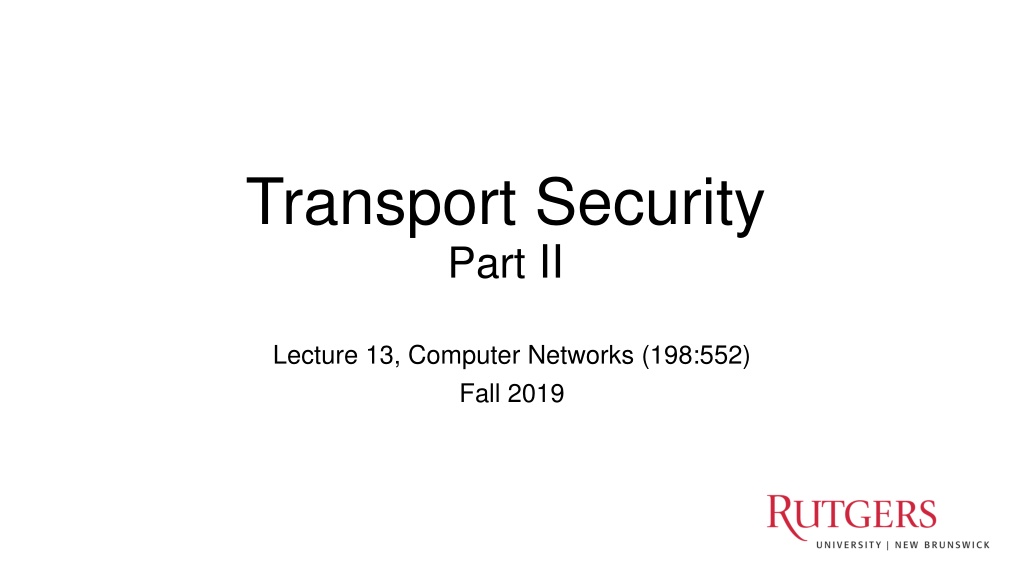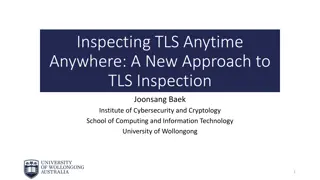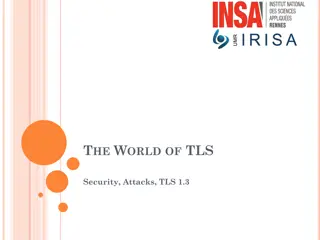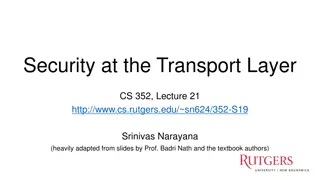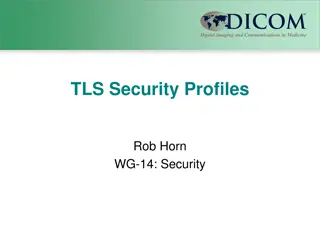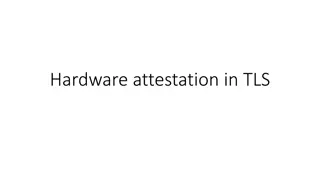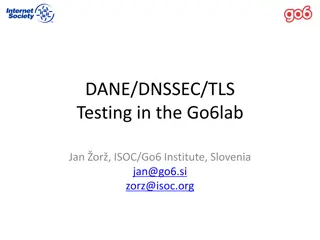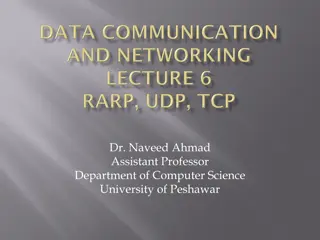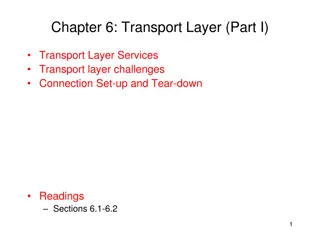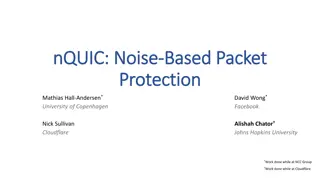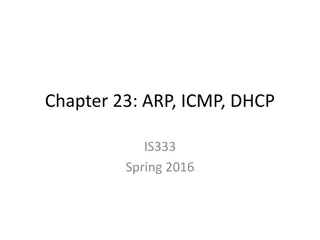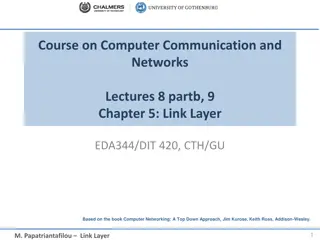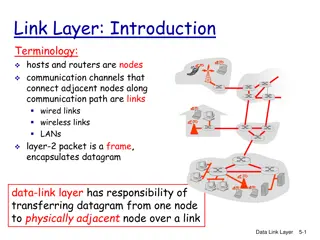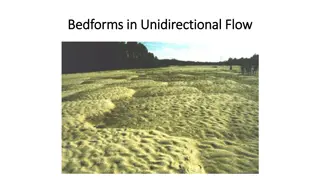Understanding Transport Layer Security (TLS)
The lecture discusses key security properties essential for secure communication in computer networks, such as confidentiality, integrity, authentication, and non-repudiation. It elaborates on cryptographic mechanisms for achieving these properties and emphasizes modularity and reusability in implementing security across applications. Additionally, the importance of security layers above the transport network is highlighted, with a focus on the practical implementation of security properties in the Transport Layer Security (TLS) protocol.
Download Presentation

Please find below an Image/Link to download the presentation.
The content on the website is provided AS IS for your information and personal use only. It may not be sold, licensed, or shared on other websites without obtaining consent from the author. Download presentation by click this link. If you encounter any issues during the download, it is possible that the publisher has removed the file from their server.
E N D
Presentation Transcript
Transport Security Part II Lecture 13, Computer Networks (198:552) Fall 2019
Review: Some key security properties confidentiality: only sender, intended receiver should understand message contents sender encrypts message receiver decrypts message integrity: sender, receiver want to ensure message not altered (in transit, or afterwards) without detection authentication: sender, receiver want to confirm identity of each other non-repudiation: Once someone sends a message, or conducts a transaction, she can t later deny the contents of that message
Review: Mechanisms to get properties Cryptography: provide confidentiality Symmetric key crypto: m = decKs(encKs(m)) public key crypto: m = decK-(encK+(m)) Key exchange problem vs. efficient computations Diffie-Hellman-Merkle key exchange Integrity: Message digest with shared secret Non-repudiation: digital signature Use public key cryptography over message digest Authentication: Use public key cryptography and nonce Certifying authority binds public key with an entity by acting as a trusted third party
How should applications use the security mechanisms described thus far? Modularity. Implement once, implement well. Reuse across many applications.
How should apps use security? Application Application Security Transport Transport Network Network normal application secure application Would be nice to provide an API to applications Useful to have security layer above transport 5
Transport Layer Security (TLS) Providing security properties in a practical protocol
Goals of TLS Confidentiality Message integrity Server authentication (optionally, client authentication) Work in the context of the existing network protocol stack
Could do something like this (PGP) KA- - KA( ) . H( ) . KA(H(m)) - KS m KS( ) . + + m Internet KB( ) . + + KS + KB(KS ) KB but want to send byte streams & interactive data want set of secret keys for entire connection want certificate exchange as part of protocol: handshake phase
TLS/SSL and the rest of the protocol stack Application Application TLS/SSL TCP TCP IP IP normal application application with TLS/SSL TLS/SSL provides application programming interface (API) to applications C and Java libraries/classes readily available Ex: OpenSSL 9
Step (1): a simple handshake MS: master secret EMS: encrypted master secret Q: What all might the master secret be used for?
Step (2): key derivation considered bad to use same key for more than one cryptographic operation use different keys for message integrity and encryption four keys: Kc = encryption key for data sent from client to server Mc = integrity digest key for data sent from client to server Ks = encryption key for data sent from server to client Ms = integrity digest key for data sent from server to client keys derived from key derivation function (KDF) Takes master secret and (possibly) some additional random data and creates the keys
Step (3): Data records why not encrypt data in constant stream as we write it to TCP? where would we put the message digest? If at end, no message integrity until all data processed. e.g., with instant messaging, how can we do integrity check over all bytes sent before displaying? instead, break stream in series of records each record carries a message digest receiver can act on each record as it arrives How does receiver distinguish the digest from data within a record? want to use variable-length records length data Message digest
Goals of TLS Confidentiality Message integrity Server authentication (optionally, client authentication) Work in the context of the existing network protocol stack Evolve as new security standards are put in place TLS implements cipher negotiation
TLS/SSL Cipher Suite Common symmetric ciphers AES Advanced Encryption Standard DES Data Encryption Standard: block 3DES Triple strength: block ChaCha: stream RC4 Rivest Cipher 4: stream SSL Public key encryption RSA with DH Integrity hashing algorithms HMAC-MD5 and others Cipher suite public-key algorithm symmetric encryption algorithm Integrity hashing algorithm TLS/SSL supports several cipher suites Negotiation: client, server agree on cipher suite client offers choices server picks one
Handshake with Negotiation 1. server authentication 2. negotiation: agree on cipher suite 3. establish necessary keys 4. client authentication (optional) TLS 1.2: All this takes a few round trip times to accomplish! 15
A typical handshake with RSA Server authenticated Client created session keys Server created session keys
A typical handshake with DHM Server authenticated Client created session keys Server created session keys
QUIC handshake Adding security in 1 (or 0) RTT to your transport connection Optimize the common case
Goals of QUIC handshake Reduce round-trip times to get set up with secure connection Initial handshake takes 1 RTT, starting from the first byte received from the client, before server can send data Later, server can send data immediately upon receiving the first byte from the client ( 0-RTT handshake)
Initial 1-RTT handshake Client first sends an inchoate (incomplete) client hello message Server REJ message contains: (1) server s long-term DHM public value (2) Certificate chain authenticating the server (3) Signature of DHM public value using the certified (private) key (4) Client source address token signed by server What properties does each of these (help) establish?
Initial 1-RTT handshake Client first sends an inchoate (incomplete) client hello message Server REJ message contains: (1) server s long-term DHM public value (2) Certificate chain authenticating the server (3) Signature of DHM public value using the certified (private) key (4) Client source address token signed by server: session ticket Useful later on to authenticate the client Prevent DoS (of server and other clients)
Initial 1RTT handshake Finish the handshake Client sends its ephemeral DHM public value to server in a complete CHLO. Server then responds with its ephemeral DHM public value. Ephemeral DH values provide forward secrecy for the communication
Other handshake details In later handshakes, client optimistically sends its source address token to the server Optimistic version negotiation: client proposes a cipher suite and encrypts first request with that cipher suite If server can t speak that cipher suite, it forces version renegotiation, similar to TLS Both techniques optimize the common case when clients speak to a known server with an agreed-upon cipher suite
Important principle Use a hash of all the plaintext data that was exchanged in the handshake when generating the symmetric key for the connection True in both TLS and QUIC Why? Example: cipher downgrade attacks Provide backward integrity over all prior messages
Server authenticated Client created session keys Server created session keys
